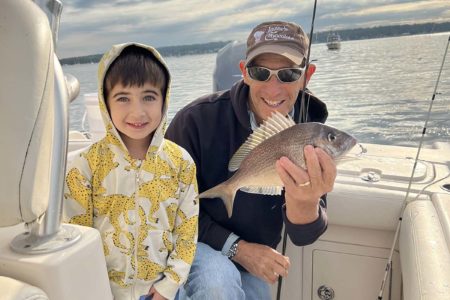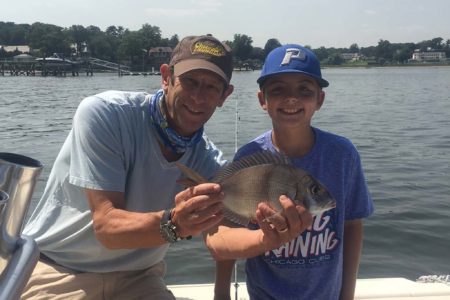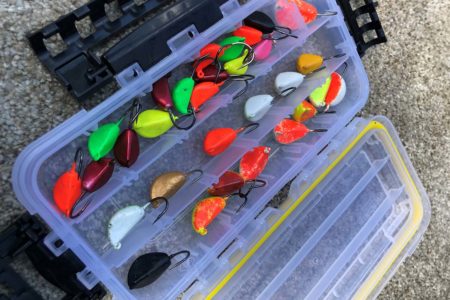
Who doesn’t love the sport of big fish on light tackle?
Are you interested in catching big porgies? Lots of anglers are and, for most, they hitch a ride on a party boat or charter boat to catch them because those boats make trips to places with lots of giant pork chops on deep shoals, wrecks, and ridges. The problem is, the use of light tackle becomes prohibitive in these places.
Deep water, some with strong bottom currents, makes light tackle fishing problematic. In this venue, heavy sinkers are needed, snags are common, and there are very large critters about including conger eels, the odd codfish, and substantial sharks ready to destroy light gear. Serious tackle is needed lest an angler catch little, annoy the captain, mates, and other anglers, and break off fish. Truly, light tackle approaches on these trips will not win you any friends. In our reality, we prefer shallow water light tackle porgy fishing.

Sand Porgies
There are plenty of porgies in the estuaries, but more often than not they are smaller there. In fact, if a giant school of 5 and 6-inch porgies takes up residence in an area, the chances are you won’t catch any large ones. In other places, fish sizes are mixed and on any given trip you may have to struggle through hours of little guys to get at a few big ones.
However, there’s good news. Just like striped bass, there are big fish and little fish spots as well as areas where they mix. I’m sure there are even bigger porgies on deep wrecks, but I think tangling with a 16-inch porgy in less than 10 feet of water on tackle that’s more commonly used for bluegill and crappie, offers genuine excitement. Okay, if you’re like me, my son Drew, and friends, this light tackle action is something you look forward each year.
Seek Or Rely On Luck
I’m an angler who looks for patterns. To that end, I do not believe it is a waste of time to prepare for a trip carefully and look for the best fishing area once on the water. Also, I don’t want to catch fish on tackle that isn’t compatible with my philosophy. I do understand folks who don’t want to lose precious fishing time searching for those special spots with big fish, and are therefore reluctant to devote time searching for a pattern. I guess my scientific training causes me to lean towards being precise instead of a haphazard approach that depends on luck. Yet, I admit when all our best tricks fail, we fall back on luck. Both methods work, and even fastidious searchers occasionally stumble on great action.
Although I prefer to find fish by analysis, I don’t turn my back on luck. Consider this example: My son Drew and I catch porgies at various places in Smithtown Bay, but often the fish average 10 inches and fish over 12 inches are rare. It’s fun, but also frustrating. On one occasion our best attempts at big fish failed, so we took a chance that was well outside our wheelhouse. We picked up the anchor and chum pot and headed toward shore purely as an exploratory endeavor. We didn’t know anything – we just gave it a shot.
The anchor went down and the chum pot followed. I put a piece of clam on an 1/8-ounce jig and lowered it 10 feet to the bottom. Frankly, I was expecting nothing or sand porgies at best, but I was wrong. The bites began instantly and hook sets followed, but when the light rod bent over to the water’s surface, I knew it wasn’t a sand porgy. Perhaps a sand shark or fluke, or even a school bass, but not a porgy. However, porgies give themselves away pretty quickly by their dogged up and down fight, and I landed a 16-inch porgy. A quick look at Drew found his rod bent over, too. We looked at each other with our mouths agape.

Special Structure
When we were done fishing, we cruised around a bit. The depth recorder revealed that we had luckily anchored on a patch of slightly elevated rough bottom that was approximately 50 by 30 feet. It was an elevated area of gravel and small rocks surrounded by sand flats. Whenever you find an isolated piece of bottom structure you’ve found something special because it will attract and hold fish while the surrounding area is barren. A piece of isolated structure isn’t big enough to feed a huge school of porgies, but there’s enough clam spat, worms, amphipods, and other small life to hold some big ones. I made a note to try this spot in the fall for blackfish. I said to Drew, “Hit the waypoint!”
The Value Of Wood
A sunken ship made of steel or a giant rock reef isn’t required to catch porgies. It turns out that wood makes wonderful structure, too. Generally, not one or two water-logged pieces, rather substantial amounts of wood such as one finds at docks, marinas, piers, and clusters of old pilings. Anglers often overlook wood structure, and truthfully not every pier or dock will attract and hold fish. However, a surprising number do, and are well-worth testing.

I’ve mentioned in other articles that my friend Rich Lazar found giant porgies in his harbor around wood docks. We were a bit shocked because, when we took his boat out to “so-called” porgy grounds, we caught lots of porgies, but rarely broke 12 inches. However, when he found them shallow around wood, we rarely caught porgies under 12 inches. Why take the boat out? Well, we still use a boat because sometimes we find monsters and besides, catching fish from a boat has its own appeal.
When one thinks about it, catching big chops around wood makes some sense. This is not new wood, rather it’s old wood that has been in the water for years. Over time, the wood becomes a magnet for shellfish spat, grass shrimp, amphipods, small crabs, fish fry, and worms that burrow in and out of the wood. It’s a fish Smorgasburg. You might be thinking why aren’t there little porgies on the wood? Good question to which I do not have a clear answer, but I do have a good guess. I believe that a school of big porgies gets on the wood and act as bullies chasing other small fish away. Often these wood structures are small and easy to defend against small interlopers.
There is a small issue with wood fishing. Most wood structures are located close to shore where the water is shallow. As a result, when the water pulls out on the ebb tide the fish leave quickly, sensing that soon there will be only inches of water. This is especially true on the North Shore where tidal ranges are huge. Therefore, we usually fish these places near high water. There’s no doubt that all species of fish in the shallows are more comfortable as the tide is rising than when it falls. Somehow, the fish sense the difference between the two and will appear sooner in shallow water on the flood than they will tolerate on the ebb. Thus, we are able to begin fishing about half-tide on the flood, the fish then hold right to the top of the tide, yet only a short time on the ebb tide.

The Drift Technique
Drifting is another way to find and catch big porgies, but there’s a disadvantage. Namely, an angler may drift into a school of big porgies but also quickly drift out of them. In some places anglers don’t anchor at all, such as off the Montauk light house because the currents are swift and that precludes chumming. If we can’t chum, then we might as well drift. Easier to do at Montauk because there are so many schools of porgies off the point and they also mix with fluke and sea bass.
However, in waters with minor tidal currents we use a strategy that sometimes works, but anglers need to be ready for it. Drew and I have done this and it can work, but it’s tricky. We have the anchor at out finger tips, the chum pot is stuffed and ready to go, and as soon as one of us is into a big fish, the other tosses the anchor on a short leash followed by the chum pot. If, and it can be a big if, the anchor sets and the chum holds the school, it’s possible to enjoy a good flurry of big porgies.
| LATE SEASON |
| Like most anglers, we return regularly to spots that we know hold fish. For example, we fish for blackfish at specific places in the fall. The thought occurred to us, since we often catch blackfish and porgies together, that these spots should be good porgy spots in summer. We’ve tried them in the spring and summer, yet productivity has been disappointing. I can’t explain this one either, because when we go to these spots in the fall, we catch porgies mixed with the blackfish and the porgies are giants. These are generally very rugged spots where an angler can lose a lot of rigs, but that neither explains their absence in the summer nor their presence in autumn. |
Drifting isn’t done on structure because of the danger of terminal tackle loss common on rugged bottoms, so we drift on more or less even bottom. Schools of fish on even bottoms tend to feed on the move and are difficult to capture with chum. Therefore, in spite of being quick to anchor and chum, a school of big ones could already be hundreds of feet away. That’s why, drifting to find big porgies is a technique we avoid unless all others fail.
Wind speed is also an important factor when drifting. The chances of capturing and holding a school of fish diminishes directly in relation to the speed of the wind, since the boat is pushed away from the school probably as fast as the fish are swimming away.
I know the following suggestion won’t sit well with some because I’ve witnessed many folks who fish with codfish tackle for porgies, even in the shallows. Still, I’ll suggest it anyway. Try this light tackle gig in the shallows and you won’t believe how much fun it is.




